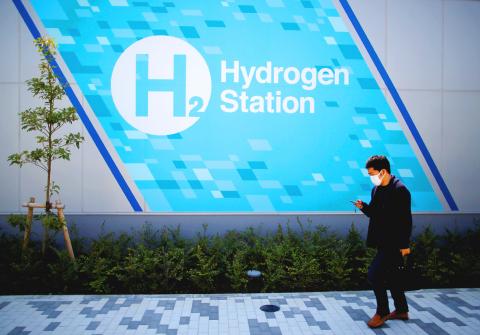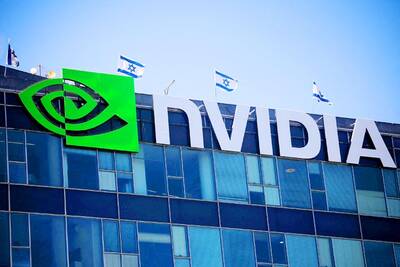Norway and Australia are racing each other to show they can supply Japan with hydrogen, hoping to fulfill its ambition to become the first nation significantly fuelled by the super-clean energy source.
While Australia has planned to derive liquid hydrogen from brown coal for some time, Norway could steal a march if a pilot project producing the fuel using “renewable” energy — a climate-friendly method more in keeping with Japan’s aims — is cheaper.
Japan is betting heavily on becoming a “hydrogen society,” despite the high costs and technical difficulties which have generally slowed its adoption as a carbon-free fuel.

Photo: Reuters
Japanese Prime Minister Shinzo Abe is pushing his vision of vehicles, houses and power stations using hydrogen to end Japan’s energy crisis since the March 2011 Fukushima Dai-ichi nuclear disaster, which led to a dramatic drop in electricity production from its nuclear plants.
The country’s annual hydrogen and fuel-cell market is forecast to hit ¥1 trillion (US$9 billion) in 2030 and ¥8 trillion in 2050, according to the Japanese Ministry of Economy, Trade and Industry.
Kawasaki Heavy Industries Ltd (KHI) is developing a supply chain to back Abe’s initiative, which is to be showcased when Tokyo hosts the 2020 Olympic Games.
KHI has been looking at using brown coal from the Australian state of Victoria, where supplies are plentiful.
However, it is hedging its bets with a project in Norway to derive hydrogen using power from hydroelectric dams and eventually wind farms.
Using Australian coal requires removing its climate-changing carbon and burying it in old oil or gas wells there.
In Norway, KHI has teamed up with Nel Hydrogen AS, a maker of hydrogen plants, with backers including Japan’s Mitsubishi Corp and Norway’s Statoil ASA. The project aims to demonstrate that liquefied hydrogen (LH2) can be produced using renewables and delivered to Japan on tankers.
Nel Hydrogen market development vice president Bjorn Simonsen told reporters that the company aims to deliver liquefied hydrogen to Japan for a minimum ¥24 per normal cubic meter. A study on the scheme is due to be completed in 2019.
KHI estimates that hydrogen from Australia costs about ¥29.8 per normal cubic meter and the company plans to establish a global LH2 supply chain like that for liquefied natural gas, KHI spokesman Keisuke Murakami said by e-mail.
“If Norway commercial [production] goes rapidly it might be earlier than Australian commercial,” he said.
Both projects still have a long way to go before they could start commercial production.
Under the Australian plan, coal would be converted to gas for processing to remove sulfur, mercury and carbon dioxide, leaving hydrogen. The Norwegian system would use renewable energy for high-temperature electrolysis to split water into hydrogen and oxygen, which would be released into the atmosphere. In both cases, the hydrogen would be liquefied for shipment to Japan.
In Australia, a small demonstration ship is being built and KHI plans to build bigger tankers in the 2020s.
The firm is also seeking support from the Victorian and federal governments, Murakami said.
A hydrogen plant would “contribute to job creation and the acquisition of foreign currencies,” he said, adding that a pilot project in Australia is scheduled to start before 2020.
Victoria is looking at the project due to the decline of brown coal mining and power stations burning the polluting fuel.
“The Victorian and Commonwealth Governments have been working with KHI on an engineering study into the possible production of hydrogen from Victorian brown coal,” Victorian Minister for Resources Wade Noonan told reporters.
The government is waiting for KHI’s results, he said.
The Japanese government is backing KHI’s Australian initiative, and budgeting ¥4.7 billion for it and related efforts this financial year, up 70 percent from the previous year. It is spending ¥22 billion backing other hydrogen initiatives.
Earlier this month, Abe called on Japanese ministers to step up efforts to “lead the world in making the hydrogen society come true.”
He called for 40,000 fuel-cell vehicles to be on the streets by the 2020 Olympics.
So far, the technology has largely been applied to cars, with hydrogen used by a fuel cell to make electricity which in turn powers the vehicle. Toyota Motor Corp launched its hydrogen-fuelled Mirai model in 2014.
However, only a few thousand Mirai — which means “future” in Japanese — are on the roads, a figure dwarfed by numbers of technically simpler battery-powered cars worldwide.
Fewer than 100 filling stations sell the fuel in Japan as safety concerns have held back development following hydrogen explosions that rocked the Fukushima Dai-ichi nuclear plant.
While Japan has high hopes of developing commercial-scale power stations using hydrogen, environmental concerns over the use of brown coal and other fossil fuels might cloud its future.
“Over 95 percent of it today comes from fossil fuels. To speak about clean hydrogen we have to clean the dirty fuel that produces it,” International Energy Agency senior renewable energy analyst Cedric Philibert said.

Shares in Taiwan closed at a new high yesterday, the first trading day of the new year, as contract chipmaker Taiwan Semiconductor Manufacturing Co (TSMC, 台積電) continued to break records amid an artificial intelligence (AI) boom, dealers said. The TAIEX closed up 386.21 points, or 1.33 percent, at 29,349.81, with turnover totaling NT$648.844 billion (US$20.65 billion). “Judging from a stronger Taiwan dollar against the US dollar, I think foreign institutional investors returned from the holidays and brought funds into the local market,” Concord Securities Co (康和證券) analyst Kerry Huang (黃志祺) said. “Foreign investors just rebuilt their positions with TSMC as their top target,

H200 CHIPS: A source said that Nvidia has asked the Taiwanese company to begin production of additional chips and work is expected to start in the second quarter Nvidia Corp is scrambling to meet demand for its H200 artificial intelligence (AI) chips from Chinese technology companies and has approached contract manufacturer Taiwan Semiconductor Manufacturing Co (TSMC, 台積電) to ramp up production, sources said. Chinese technology companies have placed orders for more than 2 million H200 chips for this year, while Nvidia holds just 700,000 units in stock, two of the people said. The exact additional volume Nvidia intends to order from TSMC remains unclear, they said. A third source said that Nvidia has asked TSMC to begin production of the additional chips and work is expected to start in the second

REVENUE PERFORMANCE: Cloud and network products, and electronic components saw strong increases, while smart consumer electronics and computing products fell Hon Hai Precision Industry Co (鴻海精密) yesterday posted 26.51 percent quarterly growth in revenue for last quarter to NT$2.6 trillion (US$82.44 billion), the strongest on record for the period and above expectations, but the company forecast a slight revenue dip this quarter due to seasonal factors. On an annual basis, revenue last quarter grew 22.07 percent, the company said. Analysts on average estimated about NT$2.4 trillion increase. Hon Hai, which assembles servers for Nvidia Corp and iPhones for Apple Inc, is expanding its capacity in the US, adding artificial intelligence (AI) server production in Wisconsin and Texas, where it operates established campuses. This

US President Donald Trump on Friday blocked US photonics firm HieFo Corp’s US$3 million acquisition of assets in New Jersey-based aerospace and defense specialist Emcore Corp, citing national security and China-related concerns. In an order released by the White House, Trump said HieFo was “controlled by a citizen of the People’s Republic of China” and that its 2024 acquisition of Emcore’s businesses led the US president to believe that it might “take action that threatens to impair the national security of the United States.” The order did not name the person or detail Trump’s concerns. “The Transaction is hereby prohibited,”